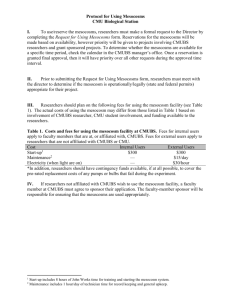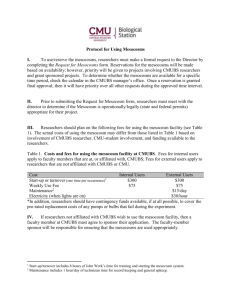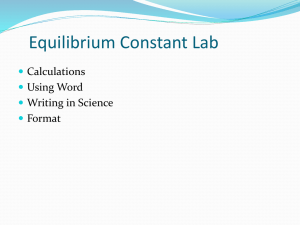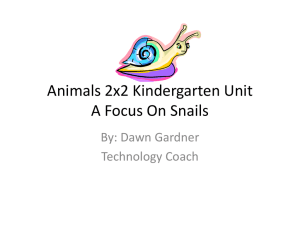ele12244-sup-0001
advertisement
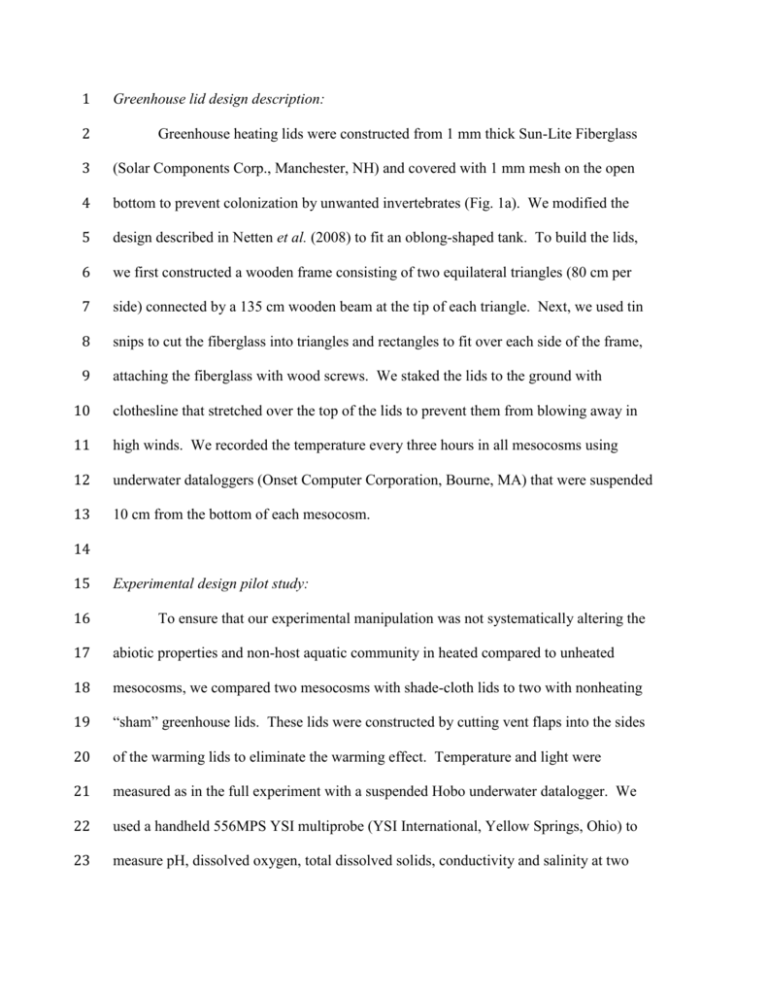
1 Greenhouse lid design description: 2 Greenhouse heating lids were constructed from 1 mm thick Sun-Lite Fiberglass 3 (Solar Components Corp., Manchester, NH) and covered with 1 mm mesh on the open 4 bottom to prevent colonization by unwanted invertebrates (Fig. 1a). We modified the 5 design described in Netten et al. (2008) to fit an oblong-shaped tank. To build the lids, 6 we first constructed a wooden frame consisting of two equilateral triangles (80 cm per 7 side) connected by a 135 cm wooden beam at the tip of each triangle. Next, we used tin 8 snips to cut the fiberglass into triangles and rectangles to fit over each side of the frame, 9 attaching the fiberglass with wood screws. We staked the lids to the ground with 10 clothesline that stretched over the top of the lids to prevent them from blowing away in 11 high winds. We recorded the temperature every three hours in all mesocosms using 12 underwater dataloggers (Onset Computer Corporation, Bourne, MA) that were suspended 13 10 cm from the bottom of each mesocosm. 14 15 16 Experimental design pilot study: To ensure that our experimental manipulation was not systematically altering the 17 abiotic properties and non-host aquatic community in heated compared to unheated 18 mesocosms, we compared two mesocosms with shade-cloth lids to two with nonheating 19 “sham” greenhouse lids. These lids were constructed by cutting vent flaps into the sides 20 of the warming lids to eliminate the warming effect. Temperature and light were 21 measured as in the full experiment with a suspended Hobo underwater datalogger. We 22 used a handheld 556MPS YSI multiprobe (YSI International, Yellow Springs, Ohio) to 23 measure pH, dissolved oxygen, total dissolved solids, conductivity and salinity at two 24 week intervals for this pilot experiment. We also measured periphyton growth at the end 25 of the month as described for the full experiment. 26 To determine whether lid type (nonheating sham vs. shade cloth) influenced 27 baseline abiotic and biotic variables, we used t-tests for variables with one measure per 28 mesocosm (temperature, light, fluorescence and periphyton), and lme models for 29 variables with measurements at two time-points (pH, dissolved oxygen, total dissolved 30 solids, conductivity and salinity). 31 There was no difference in any of the abiotic or biotic variables when tanks with 32 nonheating “sham” greenhouse lids were compared to tanks with shade cloth lids. 33 Neither temperature (t = 0.69, P = 0.56) nor light (t = 0.28, P = 0.80) differed between 34 these treatments, nor did pH (t = 0.10, P = 0.93), dissolved oxygen (t = -0.61, P = 0.58), 35 total dissolved solids (t = -0.31, P = 0.78), conductivity (t = -0.31, P = 0.78), or salinity 36 (t = -0.78, P = 0.50). Similarly, there was no difference in periphyton biomass (t = -0.23, 37 P = 0.84) or phytoplankton fluorescence (t = -1.0, P = 0.41). 38 39 40 Seeding of experimental mesocosms: On July 11, 2011 we added substrate in the form of 11 kg of silica sand, nutrients 41 in the form of 30 g of rabbit chow, microbiota in the form of 20 mL of pond sediment, 42 and 1.5 L of water containing zooplankton collected and concentrated from local pond 43 sources. Communities were given two weeks to establish prior to addition of the 44 treatment conditions and experimental focal species. Communities were composed of a 45 wide variety of species found in natural pond environments including zooplankton 46 (rotifers, hydras, copepods, cladocerans), algae (periphyton, diatoms, and filamentous 47 algae), and benthic invertebrates such as planarians, nematodes and oligochaetes. We 48 added 50 field-collected H. trivolvis snails (mean ± SE size: 7.35 mm ± 0.15, wet weight: 49 7.33 g ± 0.37) to each mesocosm two weeks later. Snails were marked with nail polish to 50 facilitate identification of the original cohort. We examined all snails for current 51 infection prior to adding them to mesocosms and dissected a subset (n=102) to ensure 52 they were free from patent or pre-patent trematode infections. We obtained parasite eggs 53 by filtering the feces of surrogate rat hosts exposed to R. ondatrae and chose realistic 54 doses of parasite eggs (~14,000 in the low infection treatment and 28,000 in the high) 55 following Johnson et al. (2012). We added equal amounts of filtered feces from 56 uninfected rats to the unexposed mesocosms. 57 58 59 Temperature effects on non-host community: To assess temperature-driven changes to the aquatic community that could have 60 influenced the environment or host food resources within the mesocosm, we sampled 61 zooplankton on 31 March 2012, by collecting water samples using a 30 cm long x 5 cm 62 diameter pvc pipe and passing them through a 45 μm sieve. We preserved these samples 63 in 70% ethanol and counted the cladocerans and copepods in each sample. We also 64 compared relative phytoplankton fluorescence among mesocosms using a fluorometer 65 (Turner Designs Instruments, Sunnyvale, CA) once before winter and three times the 66 following spring. Finally, we collected periphyton in May and August, 2012 from one of 67 two ceramic tiles (10.5 cm2) placed on the north side of each mesocosm. Samples were 68 filtered, dried and weighed to obtain estimates for periphyton growth over the duration of 69 the experiment. 70 We used linear mixed effects models, which included mesocosm as a random 71 effect, to test for interactive effects of temperature and exposure dose on zooplankton, 72 and interactive effects of temperature, exposure dose, and time on phytoplankton 73 fluorescence, and periphyton (see analysis section for full experiment for more details on 74 approach). When necessary, variables were transformed to meet assumptions of 75 normality. 76 The aquatic community was influenced by temperature differences in the heated 77 and unheated tanks. There were more zooplankton (cladocerans and copepods) and 78 phytoplankton (measured through fluorescence) in heated tanks relative to unheated 79 (Cladocerans: t = 2.44, P = 0.02; Copepods: t = 2.80, P = 0.01; Phytoplankton: t = 2.10, P 80 = 0.03). Temperature did not influence the amount of periphyton measured in tanks, 81 however periphyton levels were higher in August than in May (temperature: t = 0.31, P = 82 0.76; time: t = -7.10, P < 0.01). There was no effect of periphyton biomass on the number 83 of snails egg masses per mesocosm (Table A1). There was also no effect of 84 phytoplankton fluorescence on egg masses, and only August fluorescence values related 85 significantly (negatively) to total adult snails (Table A1). Taken together, these results 86 suggest that temperature-driven changes in primary production were unlikely to have 87 contributed significantly to the observed the changes in snail dynamics. 88 Figures: 0.6 0.4 Unheated High Exposure Heated Unexposed Unheated Unexposed Heated High Exposure Heated Low Exposure Unheated Low Exposure 0.0 0.2 Proportion Surviving 0.8 1.0 89 0 2 4 6 8 Sample Point 90 91 92 Figure A1. Snail survival curves by treatment. 10 12 14 200 150 100 Unheated High Exposure Unheated Low Exposure 50 Heated Unexposed Heated High Exposure 0 Cumulative Egg Masses Unheated Unexposed Heated Low Exposure truncated Aug 22 Sep 20 Oct 18 Mar 30 May 15 Jun 26 Jul 3 1 Date 93 94 Figure A2 Mean ± SE number of egg masses counted at each sampling date during the 95 experiment. Reduced reproduction by uninfected snails in the heated relative to unheated 96 mesocosms may have been due to thermal stress. 97 35 30 25 20 15 10 0 5 Total number shedding Adults Hatchlings HH UH UL Treatment 98 99 HL Figure A3. Mean ± SE number of adults (e.g., from the original cohort of added snails) 100 and hatchlings (snails that were >5 mm and not marked as being from the original cohort) 101 with mature infections in each treatment at the end of the experiment (HH=Heated high 102 infection, HL=Heated low infection, UH=Unheated high infection, UL=Unheated low 103 infection). Unheated Low Exposure Unheated High Exposure Heated Low Exposure Heated High Exposure 0 Number cercariae per snail 50 100 150 104 May June July Date August 105 106 Figure A4. Mean ± SE number of cercariae released per snail at each of the sampling 107 dates. Note that cercariae were not preserved at the September sampling and samples 108 were counted from 10 randomly selected snails from each mesocosm. 109 80000 60000 40000 20000 0 Mean sum of cercariae Heated High Exposure Heated Low Exposure Unheated High Exposure Unheated Low Exposure April May June July Month 110 111 Figure A5. Mean ± SE estimated number of cercariae released per month by adult snails 112 in each treatment. Note that the experiment concluded on August 14, so we do not 113 include estimates for this partial month. 114 115 Table A1. Values of linear regressions relating measures of phytoplankton 116 fluorescence or periphyton biomass to numbers of snails and numbers of egg 117 masses. Model: March Fluorometry April Fluorometry October Fluorometry August Fluorometry May Periphyton August Periphyton 118 119 Snails t-value -0.74 1.87 1.18 -2.15 -0.41 0.72 Egg Masses df p-value t-value 34 0.46 -1.05 34 0.07 1.02 34 0.25 -0.06 34 0.04* -1.3 34 0.68 -1.02 34 0.48 0.91 df 34 34 34 34 34 34 p-value 0.30 0.32 0.96 0.20 0.31 0.37 120 References: 121 Johnson, P.T.J., Preston, D.L., Hoverman, J.T., Henderson, J.S., Paull, S.H., Richgels, 122 K.L.D., et al. (2012). Species diversity reduces parasite infection through cross- 123 generational effects on host abundance. Ecology, 93, 56-64. 124 Netten, J.J.C., van Nes, E.H., Scheffer, M. & Roijackers, R.M.M. (2008). Use of open- 125 top chambers to study the effect of climate change in aquatic ecosystems. Limnol. 126 Oceanogr-Meth., 6, 223-229.
